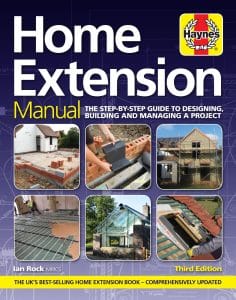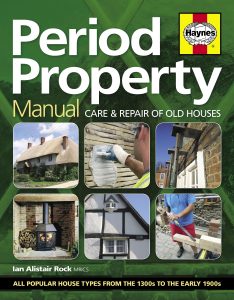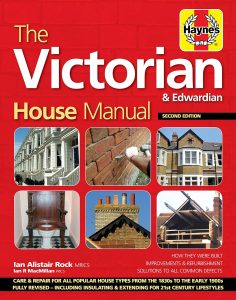Property Tips by Chartered Surveyor Ian Rock FRICS – from the Haynes House Manual series
BUYING PROPERTY
What’s The Right Type of Home Survey To Choose?
There are two main types of RICS home survey – the RICS Homebuyer Survey and the full Building Survey. In both cases a qualified chartered surveyor will inspect the building from top to bottom, from the loft down to the drains (where visible).
Each part of the building is reported on in turn, both inside and out, and any concerns flagged up. A third type of survey known as Home Condition Reports provide more limited advice and may not be carried out by RICS members.
For the vast majority of properties the less expensive Homebuyer survey (which includes a valuation and is known as an ‘HBR’) is perfectly adequate. The surveyor should spot all significant defects, including structural problems, and advise you accordingly. But for older period properties (ie those built before about 1880), or rambling residences with impressive price tags, a Building Survey offers more scope for the surveyor to dwell in some detail on their encounters with defects.
In the past, confusion sometimes arose because Building Surveys used to be known as ‘structural surveys’ or ‘full surveys’. Perhaps not realising that less expensive Homebuyer surveys also report on a building’s structural condition, customers sometimes opted for the more expensive survey when not strictly necessary.
The downside of both reports is that they do not physically test services, such as the electrics and drainage (although they will give a visual opinion of condition). The reports conclude with a summary of urgent or significant defects and may advise further investigation.
In other words, the surveyor inspects the whole building and distils it down to a few areas of concern, providing an educated opinion as to whether these are typical for the type of property. The next step is get some idea of the likely costs involved in remedying the highlighted defects, by obtaining specialist tests and reports, commonly on such matters as electrics, timber and damp, or cracking. (See ‘Specialist reports’ below.)
A more sensible system applies in Scotland. Here, at the outset, the seller pays for a three-tier home ‘Home Report’, which includes a ‘Single Survey’ along with the EPC and a property questionnaire.
Choosing a surveyor
Surveyors come in assorted shapes and sizes. Anyone can call themselves a ‘surveyor’, a title that is sometimes adopted by double-glazing salesmen for enhanced credibility.
Qualified surveyors, however, are always the chartered variety and are members of RICS (the Royal Institution of Chartered Surveyors) and bear the qualification MRICS or FRICS after their names (denoting either a Member or a Fellow – there’s little practical difference).
You will need a residential specialist (as opposed to those whose expertise lies in the fields of shops or offices, agricultural land, auctioneering, rating, quantity surveying or architectural design). You also want someone with bags of local experience.
The Internet has, of course, made finding property professionals a lot easier – see ‘Search for a surveyor’ on the website. As always, it’s worth asking friends if they can recommend anyone, but be aware that estate agents may be under commercial pressure to recommend firms with business links to their company, and may not always be the best source of impartial advice.
Banks and building societies are often very keen to arrange your survey, mainly because they get to keep a sizeable chunk of the fee.
They will probably already need to instruct a mortgage valuation on the house you’re buying, and may suggest that there is a saving to be made by having the same ‘panel surveyor’ undertake your Homebuyer or Building Survey at the same time. But in actual practice you should get a better deal by arranging the survey yourself.
Another concern about letting the lender arrange your survey is that you have no control over the quality and experience of the surveyor they appoint. Panel surveyors working for large corporate firms may be under pressure to cram as many ‘points’ into the day as possible and consequently have less time to spend doing a quality job or to take the trouble to discuss the report with you afterwards.
So when picking a surveyor there are a number of issues to consider:-
Turnaround
Assuming that getting access to the property isn’t a problem, a good surveyor should normally be able to carry out the inspection and have a Homebuyer report emailed or posted out to you within a couple of days. Building Surveys take a little longer, often about a week or so.
Talking the talk
A good surveyor should be willing to take your phone calls before and after the survey. Within reason clients should be free to make requests in advance, such as ‘Would the loft be suitable for conversion?’ or ‘Could you take a close look at the damp patch on the bedroom wall.’
At this stage in the process, everyone involved wants the purchase to go through as soon as possible. So news of defects that could hold things up is rarely welcome.
But surveyors know that buyers sometimes change their tune a few months after moving in. Suddenly every dripping tap will be blamed on them, and there will be cries of ‘I wouldn’t have bought this property if I’d known it needed a new boiler!’
So there is a fine line to tread when writing reports, alerting buyers to the potential risk of defects without scaring everyone’s pants off and derailing the purchase by overreacting to minor issues.
If it does turn out that there are some significant defects it’s important that your surveyor is willing to discuss them with you afterwards in plain English, and can clearly advise on the next course of action.
Local knowledge & experience
Surveyors should operate within a maximum radius of about 25 miles from their office, but it is not unknown for corporate firms to send surveyors twice this distance. It is always advisable to appoint someone who lives and works locally and knows the area inside out.
This means they will be aware of local risks such as those from subsidence, mining, flooding and radon. They will also be better equipped to judge property values.
Insurance
All surveyors offering services to the public must carry suitable professional indemnity insurance. This covers them and their clients in the event of a claim should they miss a serious defect. So if you move in and promptly disappear down a hole in a rotten floor that the surveyor didn’t spot, you should be able to claim compensation.
Having selected your surveyor, the normal procedure is for the surveying firm to send out a conditions of engagement form, which you need to sign and return together with payment up front.
The terms are standard RICS-approved wording that brings to your attention the various limitations found in occupied properties, such as fitted carpets and furniture, and inform you about restrictions, such as the fact that the services won’t be tested.
Interpreting the report
It’s important to bear in mind that the surveyor’s job is to point out defects, not to tell you what a lovely sunny outlook the property has. As a result, survey reports tend to read a trifle gloomily, even for the most delightful residences.
Survey reports are written in logical sequence, methodically describing all the external parts (walls, roofs, floors etc), followed by all the internal features (ceilings, walls, fireplaces etc), and then the services and grounds.
Reports increasingly define the significance of defects in terms of ‘condition ratings’ with traffic light symbols. Issues flagged up in red and orange could affect the price you are prepared to pay for the property.
RED: Condition Rating 3
Serious defects or those requiring urgent repair or replacement. These are the ‘killer items’ that need to be rectified immediately.
ORANGE: Condition Rating 2
Repair or replacement work is likely to be needed but is not currently serious or urgent. Maintenance work may be necessary.
GREEN: Condition Rating 1
No repairs are currently needed, but normal maintenance work may still be required. Observations may cover things you’ve noticed yourself, such as the tired decor and decrepit boiler, so it’s unlikely you could use these as ammunition to renegotiate the price.
Specialist reports
Where urgent or significant defects are reported in your survey, the next step is normally to get an idea about what it’s going to cost to fix the problem by obtaining quotes from contractors. In some cases, such as serious cracking, further advice from a suitable specialist, such as a structural engineer, may need to be obtained to assess the true extent of the problem.
Specialist reports are also sometimes made a requirement of mortgage valuations. But banks usually insist that mortgage valuers faithfully reproduce lender’s own ‘standard phrases’ (eg to describe structural movement or damp or timber problems).
The use of such standard phrases, sometimes drafted by lawyers with little experience of property, may automatically trigger a follow-up ‘white van man’ inspection, whether or not the surveyor in truth believes this to be necessary. This often results in unnecessary expense and hassle, and can even lead to inappropriate remedial works (such as injected chemical DPCs) damaging older buildings. The same ‘sledgehammer to crack a nut’ lending mentality applies to shrubs or trees within ‘influencing distance’ of buildings, for fear they could potentially contribute to structural damage.
This is another reason why commissioning a Homebuyer or Building Survey is advisable, since the surveyor has the scope to actually explain what they really think.
Experienced estate agents will only too familiar with the scenario where progress suddenly stalls as downhearted buyers react in horror to the news that their dream home may not be in as healthy condition as they’d imagined. But a good agent should normally be able keep things on track and organise estimates or reports for common ailments such as suspected damp and timber decay, electrical faults and cracking.
When it comes to footing the bill for specialist reports there’s often some debate as to who should pay. Splitting the cost 50/50 with the seller is sometimes an acceptable compromise.
Builders’ quotes
Surveys don’t normally include estimated costs for fixing the defects that have been highlighted. This is where builders should be able to provide estimates based on the survey report after a quick look at the house.
For more serious works, some surveyors will write a detailed specification or schedule of works, for an additional fee. This is a detailed list of the work required, which can be used to accurately price the job by obtaining builders’ quotes.
Structural engineer’s reports
All properties move and most show some signs of minor cracking, which in the vast majority of cases will not be significant.
However, some mortgage valuation forms pose questions such as ‘Are there any signs of movement?’ and then insist on a standard phrase being used, which may then trigger the requirement for an engineer’s report, even for relatively minor problems. From a lending point of view, there are basically two kinds of movement – ‘progressive’ and ‘historic’. The former is of concern because it is ‘live’ and ongoing, as opposed to something that happened in the past and is no longer a threat.
However, the cause of cracking isn’t always simple to diagnose, so even if you pay for a full Building Survey, it may still recommend that a second opinion is sought from a structural engineer, especially where a property has been underpinned or has a history of subsidence.
The engineer will then visit the property to inspect the problem and will write a brief report, usually concluding by stating whether the movement is significant or not, and advising what (if any) remedial works are required. More often than not, cracking will turn out not to be serious. But in some cases – notably those linked to insurance claims for subsidence – it is fairly common for ‘monitoring’ of cracking to be required over a period of six months or more.
This traditionally requires the fitting of a small ‘tell-tale’ measuring device across the crack, to record any ongoing movement. Which isn’t much help when you’re due to exchange next week. So in such cases the solicitors normally advise that the buyer takes over the existing buildings insurance policy, perhaps after some limited renegotiation of the purchase price.
Timber & damp reports
Over the years, many timber and damp contractors have reaped big profits carrying out totally unnecessary treatments, because mortgage lenders made such works a condition of their loans.
To add insult to injury, a lot of injected damp-proof courses and timber treatment works have been done incompetently, causing more damage to the building than they remedy. But mortgage lenders weren’t bothered as long as the contractor provided a ‘guarantee’. The problem is that the causes of damp or rot are sometimes misdiagnosed, and the ‘specialists’ who carry out the subsequent inspection have a vested interest in confirming problems that, surprise, surprise, turn out to require expensive remedial treatment.
It takes a very honest contractor to tell you they’ve checked the property and found that no work is necessary.
Damp-proofing and timber treatments for rot and beetle (woodworm) are normally carried out by a ‘timber and damp contractor’. The industry has a trade body, the Property Care Association (PCA). By all means obtain a quote for treatment, but if the problem is not serious try living with it for a while before paying good money for unnecessary work.
In many period properties it is quite normal to find a certain amount of damp and some old beetle boreholes. What may appear to be rising damp is often caused by something completely different – such as condensation, leaking gutters, defective windowsills or high ground levels. A good flow of air under timber ground floors is important to prevent rot, so check that there are sufficient airbricks in the walls near ground level, and that they aren’t blocked. If the floor is made of solid concrete it’s obviously not going to be at risk from rot.
Claims
Finally, what do you do if you move in and your roof starts leaking and the windows fall out the first time you slam the front door? If you didn’t instruct a survey, then there’s not much you can do. If you did have a survey, such defects should have been spotted and flagged up.
In the unlikely event that you have to submit a claim, the original survey firm or their insurers will appoint a qualified impartial expert to come and inspect the defect to assess whether you have the basis of a successful professional indemnity claim. The usual measure of damages is the difference between the amount the surveyor valued the house at, and what it would actually have been worth with the defects.
This may not always cover the cost of repairs, depending on the state of the property market when the property was purchased. In a booming market buyers will pay over the odds even for properties with significant defects.
Alternatively the RICS operate a dispute resolution service, which could save you time and legal fees.
We would always recommend using RICS certified surveyors in every instance – don’t get caught out, get instant quotes for RICS surveyors here.
Ian Rock’s Rightsurvey property tips are taken from the Haynes House Manual series.







